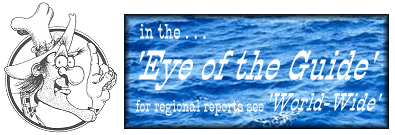SPOTTING STILLWATER TROUT
When arriving on the stillwater, the angler should try to discover where the trout are feeding and what they are feeding on. This is simply a matter of observation, but often anglers don't know how to accomplish this task without spooking those trout which are working in the shallows or feeding close to the surface.
Looking for Stillwater Trout: First I'll use a pair of binoculars and cover the water surface as far as possible. Scanning a large lake would, of course, be hard to do, but here we are talking about smaller stillwaters. You can also walk and look. Remember to stay back away from the shore line. Look for motion, rise forms, mouth movement (such as the opening and closing of the mouth of a trout feeding beneath the surface) or a flash of color.
Often you may only see a small part of the trout, so train yourself to look carefully in all the areas where you think a trout should be holding, i.e. around fallen or flood timber or in a boulder field. Also, the time of day will have something to do with the trout activity level, unless there is a major emergence of some kind like the damsel nymph migration or a flight of flying ants. You will most often find the food organisms and the trout to be most active early in the morning, say from dawn to 10 A.M., and again during the late evenings. On overcast days the trout and the food organisms may be active throughout the entire day. There is no simple answer, nor is there anything to take the place of observation and knowledge. Oh sure, we have all traveled to strange stillwaters and hit it lucky with hatches or something that induces the trout to feed. But if you rely on Lady Luck, you will find fishing the stillwaters a frustrating event indeed.
At first glance there seems to be an overwhelming amount of knowledge and information that the angler must have to be successful on the stillwaters. But much of this is simply a matter of common sense, observation and experience and the learning process can be a lot of fun. You must admit the classroom is seldom boring for the student of stillwater angling.
The Effects of Wind and Waves on the Trout & the Angler: Wind and wave action can play a major role in what, where and how the angler fishes a stillwater. There are days when the wind is so bad the best thing you can do is fish elsewhere or stay home and tie flies. (As you know the wind is seldom a problem in Montana) Often we have traveled a fair distance to fish the stillwater of choice and once we get there we find windy conditions or the wind comes up during the day. As the wind blows across the surface of a stillwater it creates currents and waves, and the angler who understands the currents and waves and how they affect the food organisms and the trout can often times find some excellent fishing during these conditions.
Waves: As a wave rolls across a stillwater 1/8th of the wave is visible on the surface while 7/8ths of the wave rolls beneath the surface. This dislodges many of the food organisms from weed beds, boulders, sunken timber and the like and pushes them into exposed areas where they become available to the trout.
Trout will often feed on the downwind side of weed beds. The trout will often cruise and feed in the zone where the wave is breaking before reaching the shoreline. Special Note: check the water temp in this breaking zone as the wave action will also pile the warmer water in the shallows and the trout will seldom feed for any length of time if the water temp is over 75.
If it is very windy, look for sheltered areas like coves or small bays where a sheltered area might be found. When fishing during this time period pick out an imitation of a popular food form which the trout have been feeding on and fish it. The type of line and the retrieve used will depend on the depth of the water being fished and the type of imitation being employed.
Not all of the fishing is done with wet flies on windy days. Often in July I have had excellent results with dry damsel imitations fished flush in the film. In August I have often found hoppers to be effective on windy days. The wind has to be really blowing to drive me off or stop me from fishing. It is simply another challenge to overcome.
